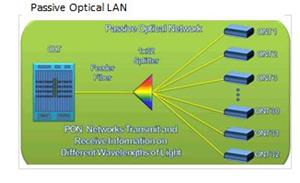by Brianna Crandall — December 25, 2015—A newly published Passive Optical LAN (POL) market briefing from U.K.-based building services and engineering consultancy BSRIA shows that the POL market is small but growing and could potentially become a threat to copper cabling in Local Area Network (LAN) applications over the coming years.
Martin Chiesa, senior researcher — IT cabling and related technologies, BSRIA, said, “POL is here to stay, but the speed at which it penetrates the market will depend on: more vendors entering the market (medium to large size corporations, particularly in the active component side), increased bandwidth without boosting costs; compatibility of systems — as opposed to proprietary solutions; and that IT network professionals, consultants, architects, developers and end-users are made aware of POL and its advantages, as well as increasing the solutions for powering remotely located ONTs (optical network terminals).
“Currently POL (ITU-T G.984) offers 2.4G b downstream and 1.2G b upstream bandwidth, but the next generation (ITU-T G987) will offer symmetrical 10 Gb bandwidth and is expected to be released in 2016. BSRIA was also informed that 25G b and 100 Gb standards are ‘imminent.’
“POL networks adapted to the LAN are disruptive technologies. They bring a number of advantages that mainly benefit the end users, as they greatly reduce capital expenditure, operational expenditure and with them the total cost of ownership of the IT infrastructure.
“Due to the market opportunity this creates, BSRIA has seen smaller networking manufacturers making great efforts to inform relevant parties about the technology and its advantages.
“For the short term, POL will continue to be a market driven by smaller players. The market will expand at double digit rates, but will only really take off when a big player or several medium-sized players enter the market with a clear go-to-market strategy — as opposed to a me-too approach — or there is a greater awareness among specifiers and the relevant parties.”
LEED, BREEAM and other environmental assessment methods can also contribute to increase awareness among consultants, architects and real estate developers, if credits are awarded as a result of installing POL on the premises, adds BSRIA.
The aim of this BSRIA study is to provide the reader with an external and independent view of the POL technology and its market. It provides a brief introduction to the technology and its advantages compared to conventional copper local area networks. This is followed by an estimate of the global market size for both passive and active components and segmentation by region. The main vertical markets are outlined and three possible scenarios for the coming years are then drawn (2015 – 2020), ending the study with BSRIA’s main conclusions.
For more information on the availability and costs of BSRIA’s reports, visit the Market Briefings Web page.





